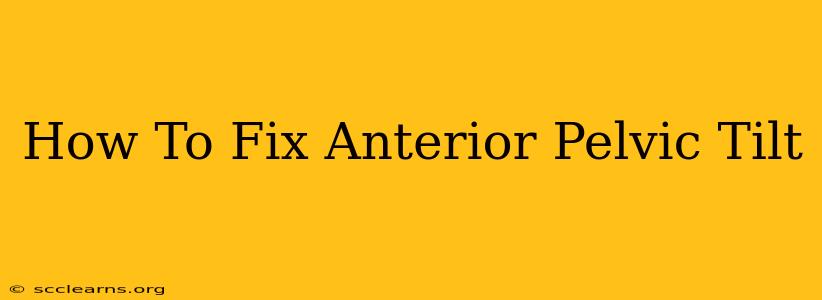Anterior pelvic tilt (APT) is a postural condition where your pelvis rotates forward, causing an increased curvature in your lower back (lordosis). This can lead to lower back pain, hip pain, and even restricted movement. Fortunately, with consistent effort, you can significantly improve or correct APT. This guide will provide you with practical strategies to fix anterior pelvic tilt and regain proper posture.
Understanding Anterior Pelvic Tilt
Before diving into solutions, let's understand what causes APT. Several factors contribute, including:
- Weak core muscles: A weak core, specifically the abdominal muscles and hip flexors, allows the pelvis to tilt forward.
- Tight hip flexors: Tight hip flexors pull the pelvis forward, exacerbating the tilt.
- Tight lower back muscles: Overly tight lower back muscles can also contribute to APT.
- Sedentary lifestyle: Spending long hours sitting can weaken core muscles and tighten hip flexors.
- Improper lifting techniques: Incorrect lifting techniques can strain the lower back and contribute to APT.
- Muscle imbalances: Disproportionate strength between opposing muscle groups (e.g., strong hip flexors and weak glutes) can lead to APT.
Effective Exercises to Correct Anterior Pelvic Tilt
The key to correcting APT is a multifaceted approach involving strengthening weak muscles and stretching tight ones. Here are some effective exercises:
Strengthening Exercises:
- Plank: A fundamental core exercise that strengthens the entire core, including the abdominal muscles and lower back. Hold a plank for 30-60 seconds, repeating 3-5 times.
- Glute bridges: This exercise strengthens the gluteal muscles, which are crucial for pelvic stability. Perform 10-15 repetitions, 3 sets.
- Bird-dog: This exercise improves core stability and strengthens the back muscles while engaging the core. Perform 10-15 repetitions per side, 2-3 sets.
- Dead bugs: This exercise improves core stability and strengthens the deep abdominal muscles. Perform 10-15 repetitions per side, 2-3 sets.
- Side plank: Targets the obliques and strengthens the core for better postural support. Hold for 30 seconds per side, repeating 2-3 times.
Stretching Exercises:
- Hip flexor stretches: These stretches target the tight hip flexors that contribute to APT. Hold each stretch for 30 seconds, repeating 2-3 times per side. Examples include the kneeling hip flexor stretch and the standing hip flexor stretch.
- Piriformis stretch: This stretch targets the piriformis muscle, which can contribute to pelvic imbalance. Hold for 30 seconds, repeating 2-3 times per side.
- Hamstring stretches: Tight hamstrings can contribute to APT. Hold for 30 seconds, repeating 2-3 times per side. Examples include lying hamstring stretches, standing hamstring stretches, and seated hamstring stretches.
- Lower back stretches: Gentle stretches can alleviate lower back tightness, reducing APT. Examples include cat-cow stretches and child's pose.
Lifestyle Modifications for Long-Term Success
In addition to exercises, lifestyle changes are crucial for maintaining proper posture and preventing APT from recurring:
- Improve your posture: Be mindful of your posture throughout the day. Sit upright with your back supported, and avoid slouching.
- Strengthen your core: Incorporate core-strengthening exercises into your daily routine.
- Stretch regularly: Regularly stretch your hip flexors, hamstrings, and lower back.
- Get regular exercise: Engage in regular physical activity to maintain overall fitness and muscle balance.
- Maintain a healthy weight: Excess weight can put extra strain on your lower back and contribute to APT.
- Ergonomic workspace: Ensure your workspace is ergonomically set up to support good posture.
When to Seek Professional Help
If you experience persistent lower back pain or other symptoms associated with APT, it's essential to seek professional help. A physical therapist or other healthcare professional can assess your condition, provide personalized exercises, and offer guidance on managing your symptoms.
Conclusion
Fixing anterior pelvic tilt requires dedication and consistency. By incorporating the exercises and lifestyle modifications outlined above, you can improve your posture, alleviate pain, and regain proper pelvic alignment. Remember that patience is key – results may not be immediate, but with consistent effort, you'll be well on your way to a healthier, stronger you. Remember to consult with a healthcare professional before starting any new exercise program, especially if you have pre-existing conditions.

